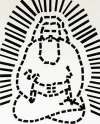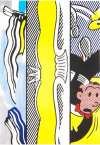American
Indian Theme
Growing up in Manhattan, Roy Lichtenstein often visited the Natural History Museum, where he developed a long-term interest in the Northwest Coast Indians. Throughout his career, until his 1997 death, Lichtenstein created prints that drew on Native American culture, reworking elements from three-dimensional objects like totems, textiles, and baskets into flat, geometric planes.
Roy Lichtenstein American Indian Theme for sale
Sell Your Art
with Us
with Us
Join Our Network of Collectors. Buy, Sell and Track Demand
Meaning & Analysis
Employing a somewhat abstract style, Lichtenstein’s American Indian theme series draws on his longtime interest in the Northwest Coast Indians. Creating up until the time of his death in 1997, Lichtenstein experimented with a broad range of styles and themes. His engagement with American Indian art spans two main periods of his career, constituted by his pre-pop oeuvre of the 1950s and his 1980s American Indian series.
Growing up on the Upper West Side of Manhattan, Lichtenstein was a frequent visitor of the American Museum of Natural History. He showed particular interest in the Hall of Northwest Coast Indians from a young age. It wasn’t before the early 1950s, however, that he decided to expand on this fascination further, through his art. The first works from that period focused on reproducing cliched images from American history books romanticising Native American heritage. Employing a somewhat abstract, and at times even Cubist style, he revised the tribal myths and symbols he came upon in the form of large scale paintings.
Lichtenstein's second encounter with traditional American Indian imagery commenced in the late 1970s and early 1980s. This time, the artist decided to treat indigenous art and design more in line with his signature Pop approach. In his American Indian Theme series, Lichtenstein primarily reshuffled elements appropriated from three dimensional everyday objects attributed to Native Americans. A broad variety of influencing source materials can be identified in this series, such as totems, textiles, beadwork, quillwork, ceramics and baskets. He reworked these into flat planes and geometric surrealist compositions. Lichtenstein’s parodic and compact forms in American Indian series strive for a multicoloured, yet minimalist presence.
It is important to note that the artist created this later series while living in Southampton, Long Island, residing near the Shinnecock Indian reservation. It is also no coincidence that Lichtenstein's revision of American Indian subject matter recurred roughly around the emergence of Native American activism. Lichtenstein applied appropriation as a tool to highlight the truth about Native identity. He aimed to contrast society’s prejudiced view of indigenous communities against the reality of their living situations. His purpose was to spark a dialogue around cultural misrepresentation.







